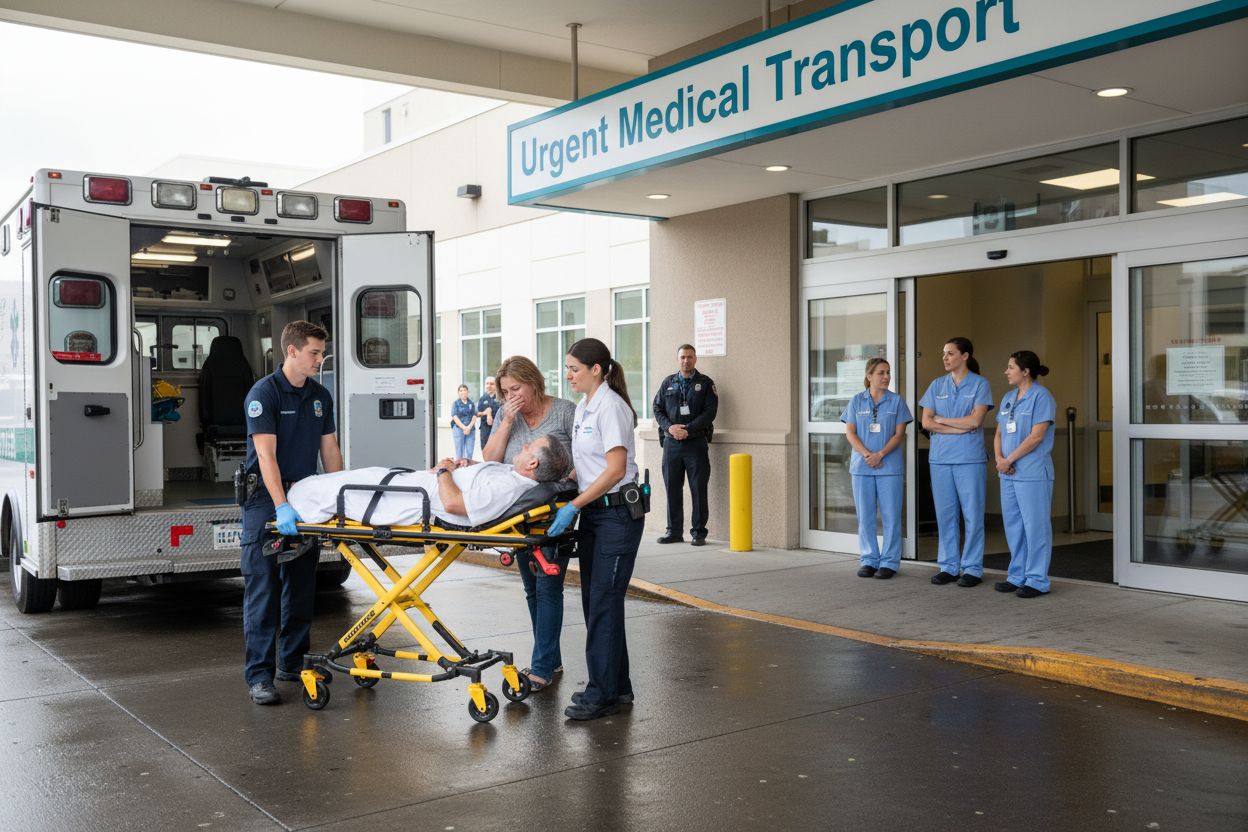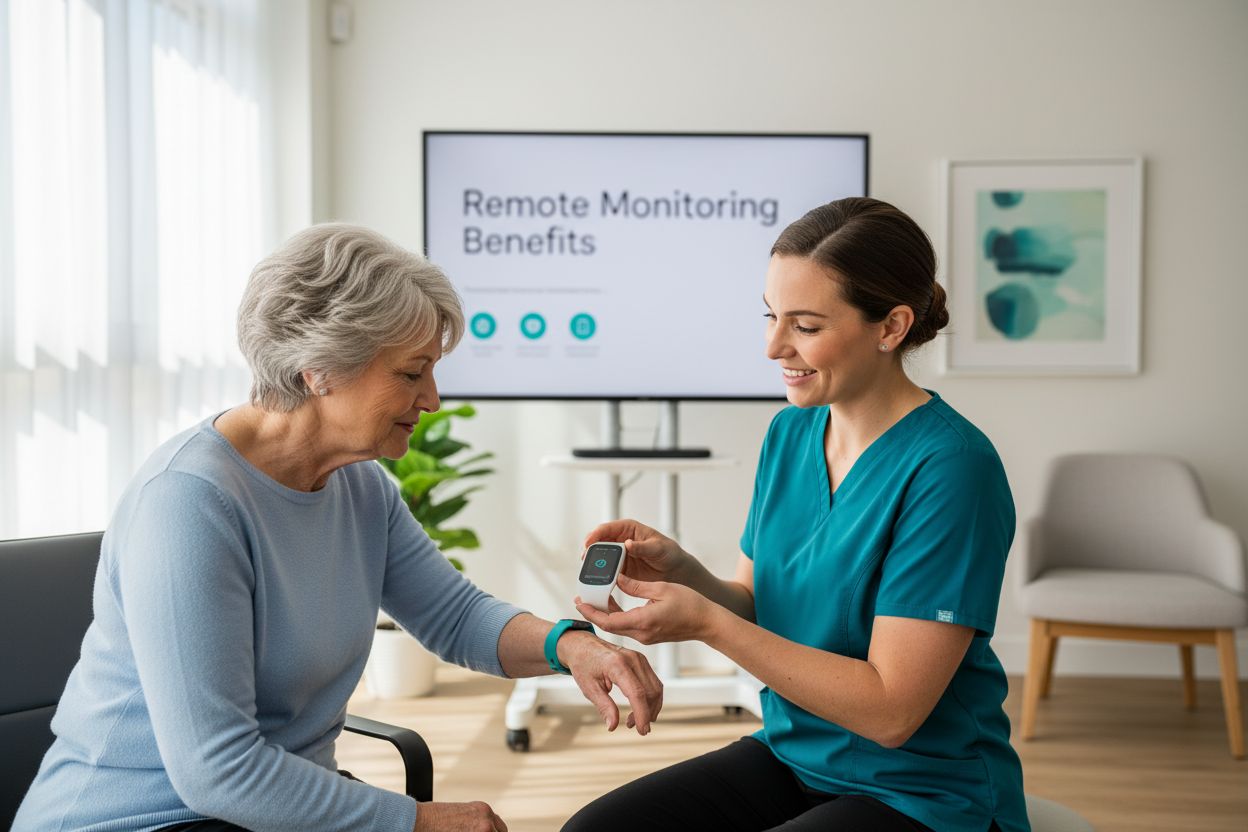Remote Work Trends 2025 for US Healthcare and EMS Leaders
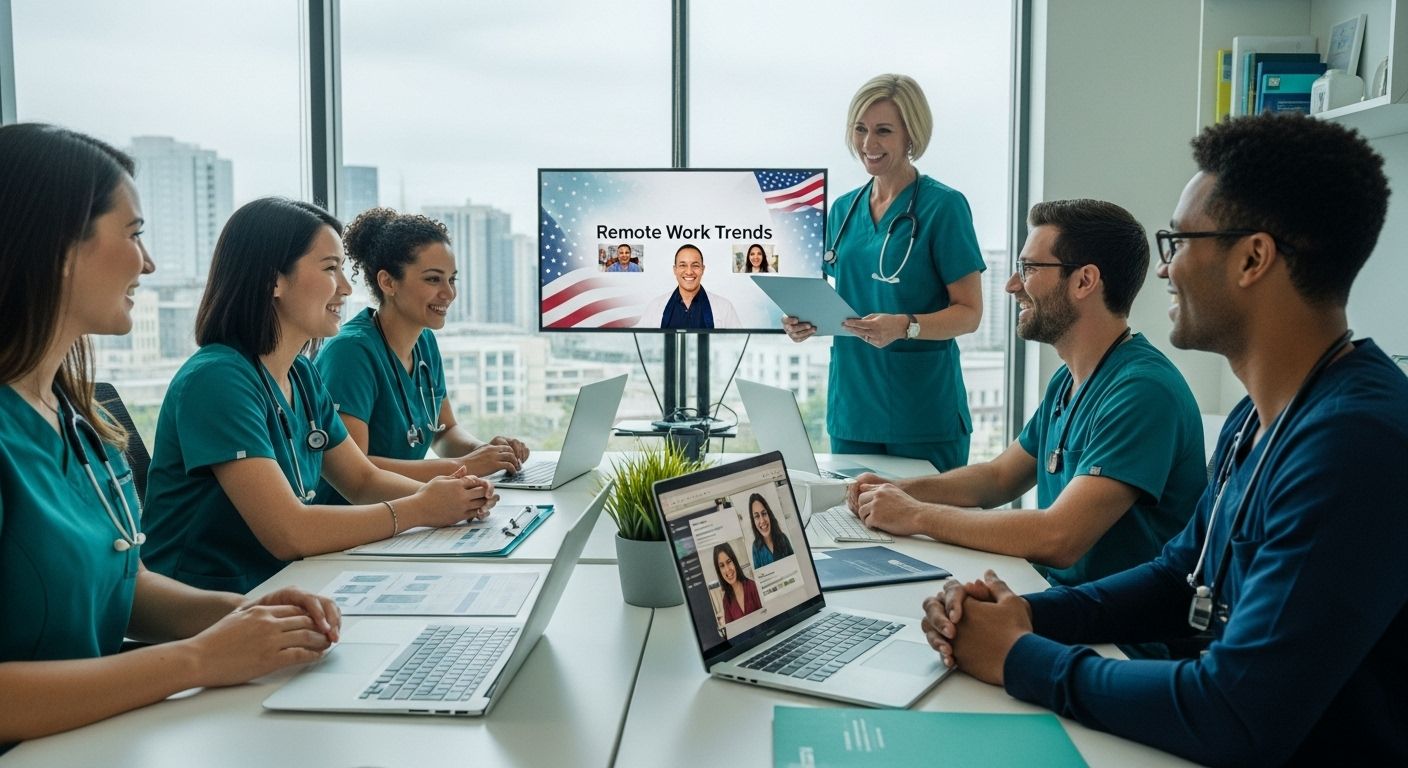
Remote work is flipping the script for US healthcare leaders. Nearly 40 percent of healthcare administrative roles can now be done remotely and that is shaking up everything from patient care to staff expectations. You might think this massive shift is just about people working from home or logging into Zoom. Actually the real change is the new team-based, tech-driven workflows that are unlocking smarter care and giving healthcare staff the power to work in ways nobody imagined just five years ago.
Table of Contents
- Shifting Work Models In Healthcare Services
- Technology Driving Remote Collaboration
- Compliance, Security, And Patient Privacy
- Improving Operational Efficiency And Patient Outcomes
Quick Summary
| Takeaway | Explanation |
|---|---|
| Adopt hybrid work models in healthcare | Incorporate remote and on-site work for flexibility and efficiency, benefiting staff and patient care. |
| Leverage advanced technology for collaboration | Use digital tools and platforms to enhance communication and streamline healthcare workflows effectively. |
| Prioritize cybersecurity and compliance | Implement robust security measures to protect patient data and meet evolving regulatory standards in remote environments. |
| Invest in workforce training for digital skills | Provide training focused on digital literacy and remote collaboration tools to empower healthcare professionals in their roles. |
| Use predictive analytics for resource management | Employ data-driven insights to optimize staff allocation and anticipate patient needs, improving service delivery and outcomes. |
Shifting Work Models in Healthcare Services
The healthcare industry is experiencing a profound transformation in work models, driven by technological advancements, workforce dynamics, and lessons learned from the global pandemic. Remote work trends for 2025 are reshaping how healthcare and emergency medical services operate, challenging traditional workplace paradigms and creating innovative approaches to patient care and organizational management.
Hybrid Work Configurations in Healthcare
Healthcare organizations are increasingly adopting flexible work models that blend remote and on-site work. Explore our guide on modern healthcare workforce strategies reveals that clinical and administrative roles are being reimagined to accommodate remote capabilities. According to McKinsey & Company research, approximately 40% of healthcare administrative roles can be performed effectively in remote or hybrid configurations.
This shift is not about completely eliminating in-person interactions but creating more dynamic work environments. Telemedicine consultations, remote patient monitoring, and digital health coordination are becoming standard practices. Emergency medical services are developing sophisticated communication platforms that allow dispatchers, coordinators, and support staff to work from decentralized locations while maintaining critical response capabilities.
Technology Enabling Remote Healthcare Workflows
Advanced digital technologies are the primary enablers of these evolving work models. Secure cloud platforms, AI-powered communication tools, and robust cybersecurity systems are creating seamless remote work experiences for healthcare professionals. Electronic health record systems now support comprehensive remote access, allowing medical professionals to review patient information, collaborate with colleagues, and make critical decisions from virtually anywhere.
The integration of sophisticated telecommunication technologies means that healthcare teams can maintain high-quality patient care without being physically present in traditional office settings. Virtual care coordination, remote triage, and digital health management are becoming increasingly sophisticated, allowing healthcare organizations to optimize their workforce deployment and reduce operational costs.
Workforce Adaptation and Professional Development
Healthcare professionals are rapidly acquiring new digital skills to thrive in these emerging work models. Training programs are now focusing on digital literacy, remote collaboration tools, and advanced telecommunication technologies. Organizations are investing in comprehensive upskilling initiatives to ensure their workforce can effectively navigate these new professional landscapes.
The remote work trends of 2025 represent more than just a technological shift they signify a fundamental reimagining of how healthcare services are delivered. By embracing flexible work models, healthcare organizations can attract top talent, improve employee satisfaction, and create more resilient and adaptable service delivery mechanisms.
As the healthcare industry continues to evolve, these remote work trends will play a crucial role in shaping more efficient, accessible, and patient-centered care models. The future of healthcare work is not about location but about creating seamless, technology-enabled experiences that prioritize both professional effectiveness and patient outcomes.
Technology Driving Remote Collaboration
In the rapidly evolving healthcare landscape, technology has become the critical backbone enabling seamless remote collaboration across emergency medical services, hospitals, and healthcare networks. The remote work trends of 2025 are characterized by sophisticated digital platforms that transcend traditional communication barriers, creating interconnected and responsive healthcare ecosystems.
Advanced Communication Infrastructure
Healthcare organizations are deploying cutting-edge communication technologies that facilitate real-time information exchange and team coordination. According to research from the Journal of Medical Internet Research, telehealth platforms have revolutionized how medical professionals interact, share critical patient information, and collaborate across geographical boundaries.
Secure video conferencing tools, integrated messaging systems, and cloud-based collaboration platforms are now standard in healthcare settings. These technologies enable multidisciplinary teams to conduct virtual case conferences, perform remote consultations, and coordinate complex patient care strategies without physical proximity constraints.
To clarify the main technologies driving remote work in healthcare, here’s a summary table outlining key digital tools and their primary roles as discussed in the section.
| Technology Type | Key Features & Functions |
|---|---|
| Secure Video Conferencing Tools | Real-time collaboration, virtual consultations, team meetings |
| Integrated Messaging Systems | Instant communication, case coordination, encrypted chats |
| Cloud-Based Collaboration | Centralized document sharing, workflow management, team tracking |
| AI-Powered Communication Tools | Automated routing, predictive analytics, urgent message prioritization |
| Encrypted Patient Data Platforms | HIPAA-compliant patient info sharing, privacy protection |
| Real-Time Location Tracking | EMS coordination, patient transport monitoring |
| Virtual Consultation Modules | Remote diagnostics, specialist discussions, patient interviews |
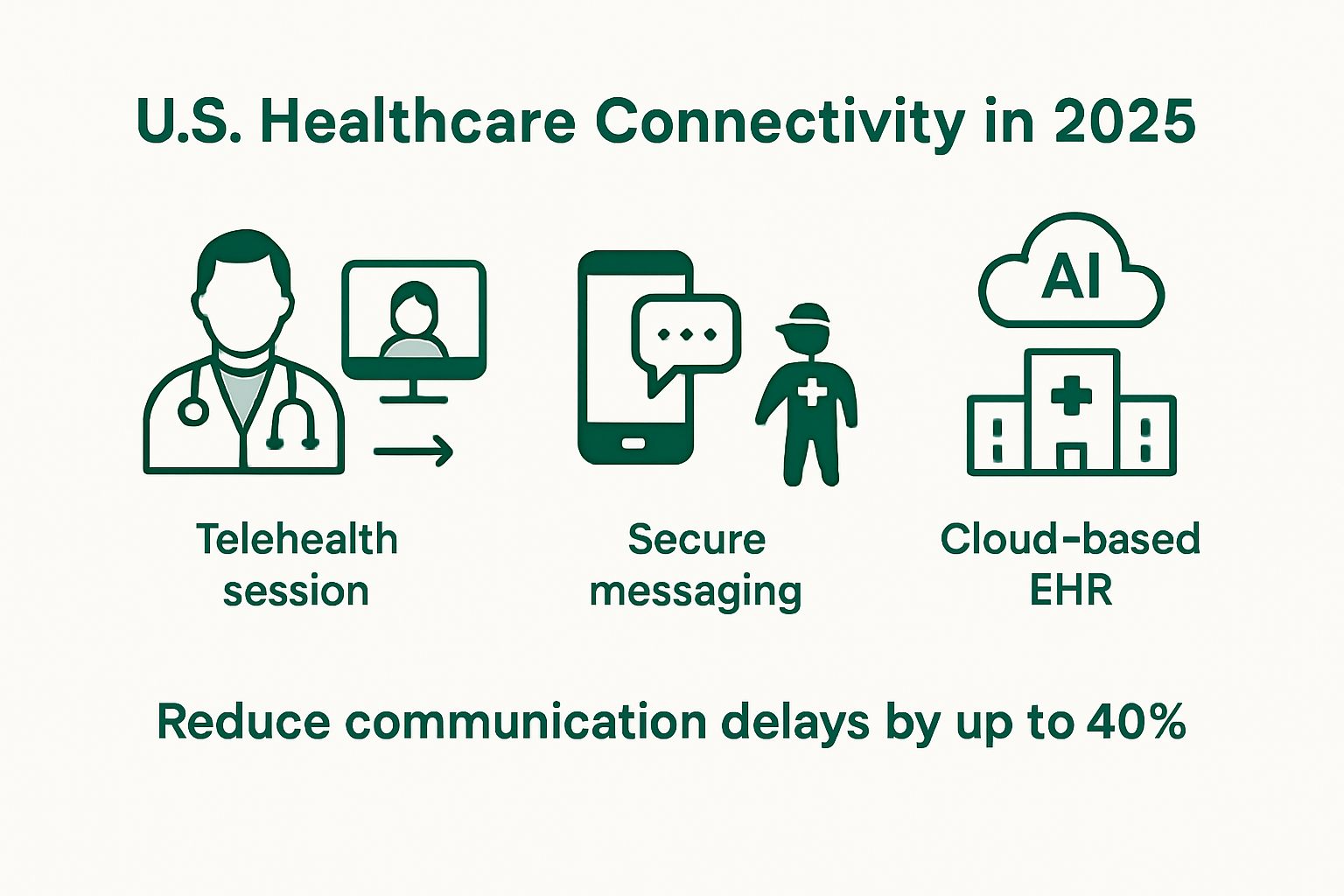
Integrated Digital Health Platforms
Modern digital health platforms are designed to unify communication channels, electronic health records, and workflow management tools. Gartner’s Healthcare Technology Research indicates that integrated platforms can reduce communication delays by up to 40% and improve interdepartmental collaboration efficiency.
These platforms support multiple functionalities including:
- Secure Patient Data Sharing: Encrypted networks that comply with HIPAA regulations
- Real-Time Location Tracking: For emergency medical services and patient transport coordination
- Virtual Consultation Modules: Enabling remote diagnostic discussions and specialist consultations
AI and Machine Learning Enhancement
Artificial intelligence is transforming remote collaboration by introducing predictive analytics, automated workflow optimization, and intelligent communication routing. Machine learning algorithms can now anticipate communication needs, prioritize urgent messages, and provide context-aware collaboration suggestions.
For emergency medical services, AI-driven platforms can dynamically route communication, optimize resource allocation, and provide immediate contextual information during critical response scenarios. This technological approach ensures that remote teams maintain high-performance communication standards, even in complex and time-sensitive healthcare environments.
The convergence of advanced communication technologies, integrated digital platforms, and intelligent systems is redefining how healthcare professionals collaborate. Remote work is no longer just a flexible arrangement but a sophisticated, technology-enabled approach to delivering comprehensive and responsive patient care.
As healthcare continues to embrace digital transformation, these technological innovations will be instrumental in creating more agile, efficient, and patient-centered healthcare delivery models. The future of healthcare collaboration is not just about connecting people but about creating intelligent, adaptive communication ecosystems that can respond dynamically to emerging healthcare challenges.
Compliance, Security, and Patient Privacy
In the era of remote work trends for 2025, healthcare and emergency medical services face unprecedented challenges in maintaining robust compliance, security, and patient privacy frameworks. The digital transformation of healthcare requires a comprehensive approach that balances technological innovation with stringent protective measures.
Evolving Regulatory Landscape
Healthcare organizations must navigate an increasingly complex regulatory environment that demands sophisticated data protection strategies. Learn more about managing credentialing risks highlights the critical importance of maintaining rigorous compliance standards. According to HIMSS cybersecurity research, healthcare institutions are experiencing a significant increase in cybersecurity challenges, with insider threats and social engineering becoming more sophisticated.
The regulatory framework continues to expand, with new guidelines addressing remote work security, telehealth privacy, and cross-platform data protection. Healthcare providers must implement comprehensive compliance programs that adapt to these evolving requirements, ensuring that remote work models meet or exceed existing regulatory standards.
Advanced Security Protocols
Cybersecurity in healthcare has transcended traditional protection methods. A systematic review of telehealth security identifies critical risk factors across environmental, technological, and operational domains. Organizations are now implementing multi-layered security approaches that include:
This table provides an overview of the main advanced security protocols implemented by healthcare organizations to protect patient data and support remote work.
| Security Protocol | Description & Role |
|---|---|
| Endpoint Detection | Monitors and protects remote access points, detects suspicious activity |
| Encryption Technologies | Safeguards data transmission and storage, ensures confidentiality of patient information |
| Secure Authentication | Uses methods like multi-factor authentication and zero-trust security models |
| AI & Machine Learning | Identifies emerging threats, automates threat detection and prevention |
| Security Training | Educates staff on risks, protocols for secure remote work, increases privacy awareness |
- Endpoint Detection: Advanced monitoring systems that track and protect remote access points
- Encryption Technologies: Comprehensive data protection for patient information across communication channels
- Secure Authentication: Multi-factor authentication and zero-trust security models
Emergency medical services are particularly focused on developing secure communication platforms that protect sensitive patient data while enabling rapid information exchange. The integration of artificial intelligence and machine learning has introduced more sophisticated threat detection and prevention mechanisms.
Patient Privacy in a Digital Ecosystem
The EMS Compact’s position paper emphasizes the critical importance of protecting personally identifiable information (PII) in remote healthcare environments. Emerging privacy frameworks are developing more nuanced approaches to data protection that go beyond traditional compliance checklists.
Healthcare organizations are investing in comprehensive training programs that address the human element of cybersecurity. This includes educating healthcare professionals about potential security risks, developing protocols for secure remote work, and creating a culture of privacy awareness.
The future of healthcare compliance and security is not about creating impenetrable barriers but about developing intelligent, adaptive systems that protect patient information while enabling efficient and innovative care delivery. As remote work becomes increasingly prevalent, the ability to balance technological innovation with robust security measures will be a critical differentiator for healthcare organizations.
Ultimately, the goal is to create a secure digital ecosystem that protects patient privacy, enables seamless communication, and supports the evolving needs of healthcare professionals in an increasingly connected world.
Improving Operational Efficiency and Patient Outcomes
The remote work trends of 2025 are fundamentally transforming how healthcare organizations optimize operational efficiency and drive improved patient outcomes. By leveraging advanced technologies and flexible work models, healthcare providers are creating more responsive, adaptive, and patient-centered service delivery mechanisms.
Digital Workflow Optimization
Explore our insights on patient flow optimization reveals the critical role of digital technologies in streamlining healthcare operations. According to research from the National Institutes of Health, digital transformation is directly associated with significant improvements in staff efficiency and patient care continuity.
Healthcare organizations are implementing intelligent workflow management systems that enable remote teams to coordinate patient care more effectively. These systems use predictive analytics and real-time data tracking to identify bottlenecks, optimize resource allocation, and reduce administrative overhead. By eliminating manual processes and enabling seamless communication, healthcare providers can focus more energy on direct patient care.
Resource Allocation and Predictive Management
Advanced data analytics are revolutionizing how healthcare organizations manage resources and predict patient needs. Machine learning algorithms can now analyze historical patient data, current health trends, and operational metrics to provide actionable insights for more efficient service delivery.
Key capabilities of these predictive management systems include:
- Dynamic Staff Scheduling: Optimizing workforce deployment based on predicted patient volumes
- Equipment and Supply Management: Anticipating medical supply needs and reducing waste
- Patient Risk Stratification: Identifying high-risk patients who require proactive interventions
Emergency medical services are particularly benefiting from these technologies, enabling more precise resource allocation during critical response scenarios. By understanding potential demand patterns, EMS teams can strategically position personnel and equipment to minimize response times and improve patient outcomes.
Integrated Care Coordination
Remote work technologies are breaking down traditional silos between different healthcare departments and service providers. Coordinated platforms are uniting private and public healthcare interests to create more holistic, patient-centered care ecosystems.
These integrated platforms enable seamless information sharing across various healthcare touchpoints, from primary care physicians and specialists to emergency services and home health providers. By creating a more connected healthcare environment, remote work technologies are facilitating more comprehensive, continuous patient care.
The convergence of remote work, advanced technologies, and data-driven insights is creating a new paradigm in healthcare service delivery. Organizations that successfully implement these strategies can expect significant improvements in operational efficiency, staff satisfaction, and most importantly, patient outcomes.
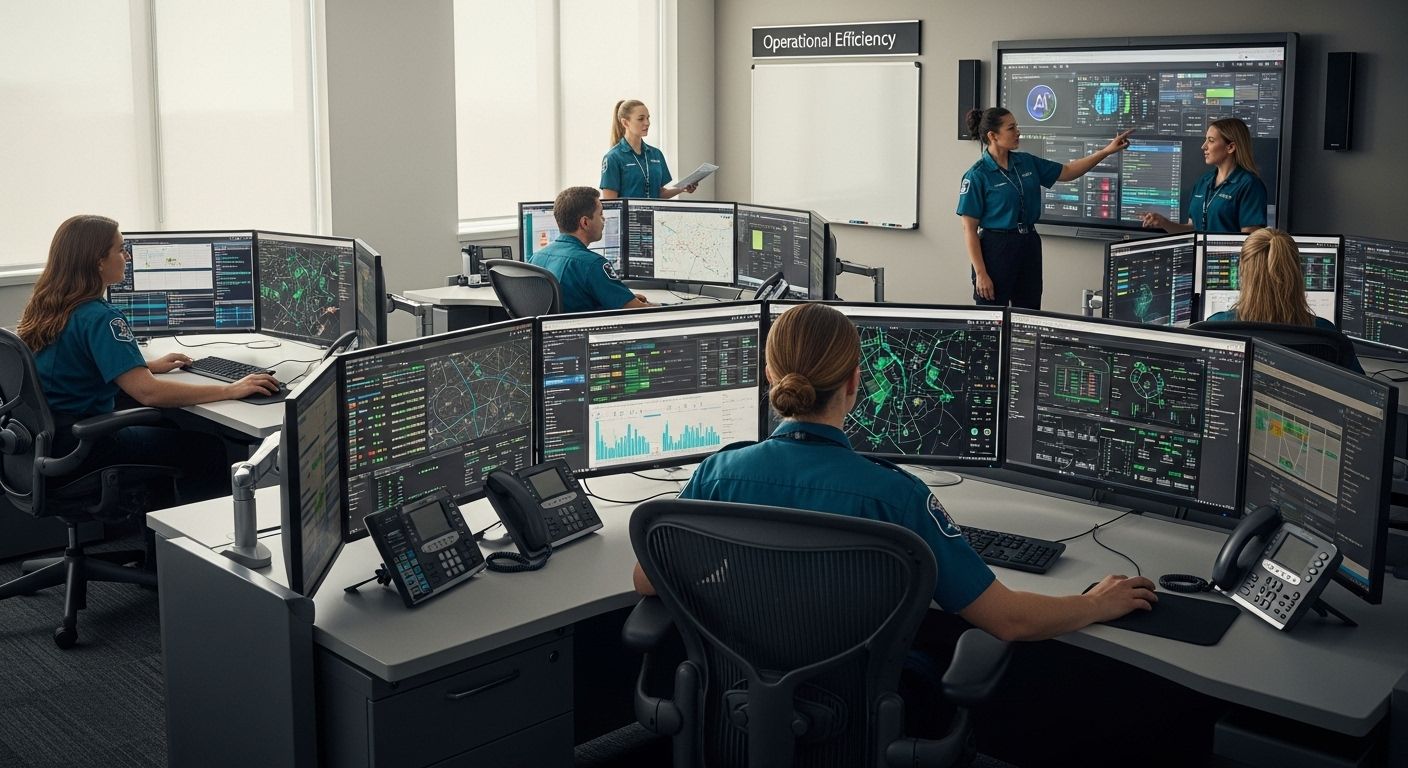
As healthcare continues to evolve, the ability to leverage remote work technologies will become a critical differentiator. The most successful organizations will be those that can create flexible, intelligent, and patient-focused care delivery models that adapt quickly to changing healthcare landscapes.
Frequently Asked Questions
What are the key trends in remote work for healthcare in 2025?
In 2025, healthcare trends include hybrid work models combining remote and on-site work, advanced communication technologies facilitating collaboration, and a stronger focus on cybersecurity and compliance to protect patient data.
How can healthcare organizations optimize operational efficiency through remote work?
Healthcare organizations can enhance operational efficiency by implementing intelligent workflow management systems, using predictive analytics to manage resources, and promoting integrated care coordination across departments.
What role does technology play in remote healthcare workflows?
Technology plays a crucial role by supporting secure communication, facilitating remote access to patient records, enabling telemedicine, and automating administrative tasks, allowing healthcare professionals to provide better patient care even when working remotely.
How should healthcare professionals prepare for successful remote work?
Healthcare professionals should invest in digital skills training focused on remote collaboration tools, understand security protocols to protect patient information, and be adaptable to new technologies that enable seamless communication and efficient care delivery.
Transform Remote Healthcare Challenges Into Seamless Patient Logistics
Struggling to adapt your workflows to the rapid rise of hybrid and remote work in healthcare? If your organization is feeling weighed down by fragmented tools and rising backlogs, know that you are not alone. The latest trends highlight recurring issues like inefficient team communication, difficulty tracking patient transportation, and a lack of real-time insights for quick decision-making. In a world where operational speed and patient outcomes matter more than ever, traditional systems can leave your teams frustrated and your patients waiting.
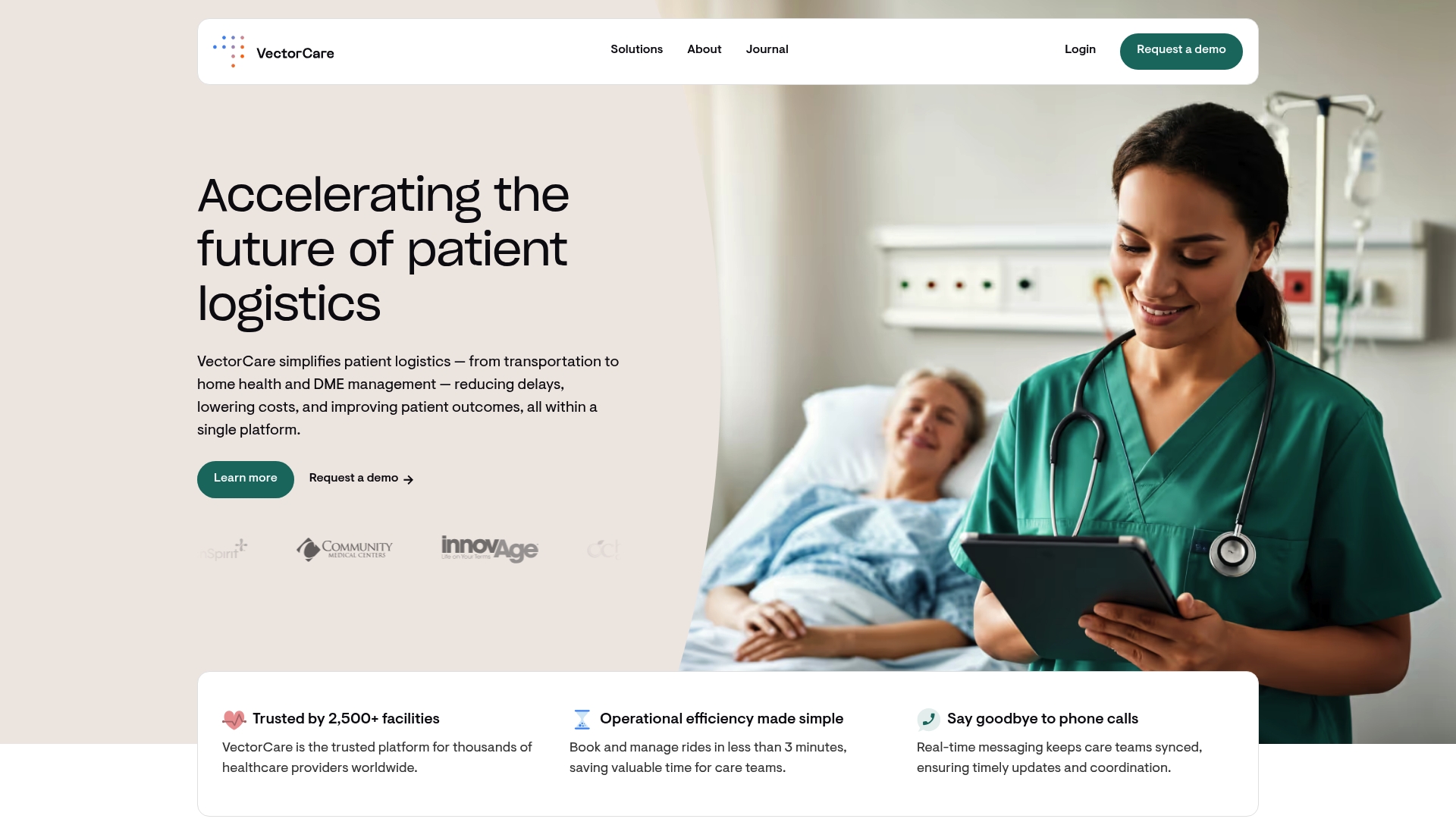
It is time to break away from outdated processes and move toward smarter, automated coordination. VectorCare’s integrated platform empowers healthcare leaders to truly leverage remote work trends. With our secure scheduling optimization, automated dispatch, and no-code workflow solutions, you can:
- Unify your care teams and vendors while working from anywhere
- Gain real-time status updates for every patient journey
- Improve compliance and reduce costly errors through secure communication
Take the next step forward. Explore VectorCare now and discover how you can streamline operations, protect patient privacy, and deliver exceptional care. This shift is happening right now—make sure your organization stays a step ahead.
